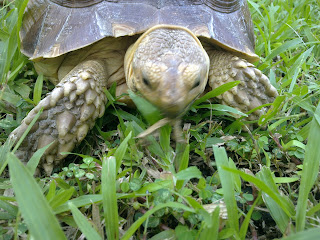I often come across the question about what comprises a healthy geochelone sulcata tortoise diet. So I have compiled a list from my reliable sources as well as based on my own experience. Our diet should comprise "70% grass", and "30% other greens & flowers & other sources of multiminerals" to ensure that we get as much amount of fiber, calcium & multiminerals to stay healthy. Baby sulcata tortoises & juveniles like myself are especially in need of high amounts of dietary calcium and an adequate source of vitamin D3 (ex: UVB from unfiltered sunlight) to support our rapid growth stage. Remember that when choosing what to eat, high fiber, high calcium, very very low phosphorous or phosphorus-free, very low protein, no sugar, multiminerals, organic/pesticide-free/artificial-fertilizer-free and variety are the important keywords to keep in mind =) Happy nomz nomz!!!
Flowers as Part of 30% of Our Diet (organically grown/ no pesticides/ no chemical fertilizer):
• Gumamela flowers or Hibiscus flowers & its leaves (also available in most of Southeast Asia)
• Dandelion flowers & its leaves
• Petunia
• Hibiscus flowers
• Hibiscus flowers
• Viola sp
• Rose petals
• Santan flowers (comes in color orange, yellow & pink; available in most of Southeast Asia)
• Pumpkin flowers / Squash flowers or "Bulaklak ng Kalabasa" (also available in most of Southeast Asia)
• Yellow bell flowers (also available in most of Southeast Asia)
• Yellow bell flowers (also available in most of Southeast Asia)
 |
| Here I am stuffing my face with pumpkin flower or Squash flower or "Bulaklak ng Kalabasa". I've just discovered this last month! nomnomz nomnomz nomz! |
Other Foods as Part of 30% of Our Diet:
70% of Our Diet Should Be Comprised of Grasses & Hays (organically grown/ no pesticides/ no chemical fertilizer):
• Non-toxic weeds like clovers
• De-spined Opuntia pads <<-- This is very rich in calcium :)
• De-spined prickly pear pads
• Squash (bite size cubes) - eat a serving once a week for vitamin A to avoid eye infection & loss of eyesight
• Squash (bite size cubes) - eat a serving once a week for vitamin A to avoid eye infection & loss of eyesight
• "Kangkong" or water spinach or water convolvulus (Scientific name: Ipomoea aquatica; Also available in most of Southeast Asia)
70% of Our Diet Should Be Comprised of Grasses & Hays (organically grown/ no pesticides/ no chemical fertilizer):
• Carabao grass or Buffalo grass
• Couch grass
• Kikuyu grass
• Dallas grass
• Blue Grama grass
• Big Bluestem grass
• Darnel Rye grass
• Wintergrass or Bluegrass
• Western Wheatgrass
• Fescue sp. grasses”
** Don't munch on hays that have excessively “prickly” seed heads, as these can hurt our mouths or eyes :'(
 |
| Grass & hays should comprise 70% of our diet -- but don't ignore the other 30% for other foods too, as these are our other source of calcium & multiminerals essential for our health. |
IMPORTANT: One more thing, unless you live in the arid savannah, which is our natural habitat (and I highly doubt this, as there are no computers to view this blog from in the wild lol!) where nature provides a tremendous variety of food rich in dietary calcium & multiminerals & ample exposure to vitamin D3 from all-day access to unfiltered sunlight, I would highly suggest that you supplement your daily diet with a "powdered phosphorus-free source of calcium and vitamin D3" like "Rep-Cal" or "Miner-All". If you live very near the equator like me where the sunshine emits a highly concentrated amount of UVB rays and you also stay out in the sun at least 4 to 5 hours a day, then I would suggest that you take a "powdered phosphorus-free source of calcium WITHOUT vitamin D3" like Nutrobal which also contains multiminerals (But when the rainy season or cold season arrives please revert back to a "powdered phosphorus-free source of calcium WITH vitamin D3" supplement); Ask your tort's veterinarian where you could buy this or maybe order it on Ebay. It would also be great to have a cuttlefish bone in your enclosure to help you "self regulate" your own calcium intake, as well as help trim your beak! I don't have a cuttlebone yet -- I wish I do -- but having one is a best practice recommended by my expert & highly experienced source, Tortoise Trust. Again, please buy a multi-minerals supplement that does not contain Phosphorous because almost all greens already contain an abundant amount of phosphorous while only very small trace amounts of calcium or none can be found in the grasses and greens that I eat. We are aiming for a Calcium : Phosphorous ratio of 2:1 or 3:1. Phosphorous inhibits calcium absorption.
Happy nomx nomx!!!
You May Also Want To Read Some of My Other Related Blog Posts:
• For My Fellow Torts Refusing to Eat - Force Feeding Resource Materials
• For My Fellow Torts Refusing to Eat - Force Feeding Resource Materials







